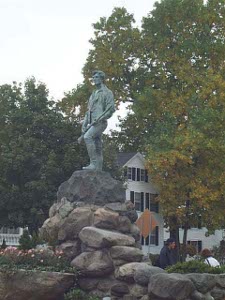 Masonic Indian
Masonic Indian
Although most of our time recently has been spent in various libraries and graveyards (no -- they are not at all similar!), we have managed to find some examples of American nostalgia.
 Masonic Indian
Masonic Indian
In Lee, Massachusetts, we stopped for lunch one day at Joe's Diner, a storefront clearly unchanged for many decades. Inside, the counter and stools were vintage 40's, with formica-topped tables as well. As we ate our sandwiches we examined dozens of photos on the wall, gradually becoming aware that all of them had the same theme: two people at the counter talking to Joe, who was posed between them. When we saw the framed Norman Rockwell jig-saw puzzle against the back wall, the mystery was solved. One of Rockwell's most famous Saturday Evening Post covers, widely used as a veritable symbol of America, was painted here. A small boy sits on a big stool at a soda fountain counter, next to a husky cop, and leaning over the counter in between them ... is Joe.
We hate to admit our ignorance, but here goes: we were driving along Route 2 in Massachusetts, westward bound, when we spied a large statue of an indian at a roadside park. "What's that?" we wondered, and stopped to look. Along with the statue there was a fountain with pieces of cut stone cemented in place, each bearing the name of an Indian tribe and the name of a person. We  Minuteman
were confused, but we thought they must be the names of tribal leaders gathered for a powwow (modern powwows are, after all, popular in Ridgecrest, California.) We even thought that the reason the names of people inscribed on the stones represented virtually every ethnic group in America was because the indians had intermarried. It was only later on that we understood that this park was dedicated by the Masonic Improved Order of Red Men. Oops!
Minuteman
were confused, but we thought they must be the names of tribal leaders gathered for a powwow (modern powwows are, after all, popular in Ridgecrest, California.) We even thought that the reason the names of people inscribed on the stones represented virtually every ethnic group in America was because the indians had intermarried. It was only later on that we understood that this park was dedicated by the Masonic Improved Order of Red Men. Oops!
The Lexington and Concord area is just as crowded and touristy as you'd expect, with lots of emphasis on The Shot Heard Round The World. You can buy a special package ticket for entry into various historic houses; we passed, although we did photograph the Minute Man Statue - the symbol of Reservists! If you want to visit Walden Pond it will cost you $5.00 to park, but a quick turn-around in the parking lot affords a glimpse of Thoreau's tiny cabin.
Near Historic Concord is the Museum Of Our National Heritage. It's free, charming and a nice taste of philanthropy. The museum is a major project of the Scottish Rite Masons, who made it their Bicentennial effort. Currently it  Fall color
offers an exhibit on the beginning of the Revolutionary War, including a reconstructed parlor and chapel from the period, an exhibit of wonderfully wacky cuckoo clocks made by a New Englander, an educational survey From Dairy To Doorstep, and an informative gallery of objects associated with the rituals of the Masonic Order, especially from the 19th century, when these groups reached their greatest membership. Yes, it was at this museum that we learned about the Improved Order of Red Men! Even though lots of our ancestors were Masons, our parents were not, and we had grown up ignorant of this fraternity.
Fall color
offers an exhibit on the beginning of the Revolutionary War, including a reconstructed parlor and chapel from the period, an exhibit of wonderfully wacky cuckoo clocks made by a New Englander, an educational survey From Dairy To Doorstep, and an informative gallery of objects associated with the rituals of the Masonic Order, especially from the 19th century, when these groups reached their greatest membership. Yes, it was at this museum that we learned about the Improved Order of Red Men! Even though lots of our ancestors were Masons, our parents were not, and we had grown up ignorant of this fraternity.
The leaves are dropping quickly now, and all the hillsides have gray patches of bare branches. But the autumn scenery is still lovely. What a treat to be in New England throughout the changing of the colors on the hillsides! On the other hand, we're glad we don't have one of those huge yankee lawns to rake up!